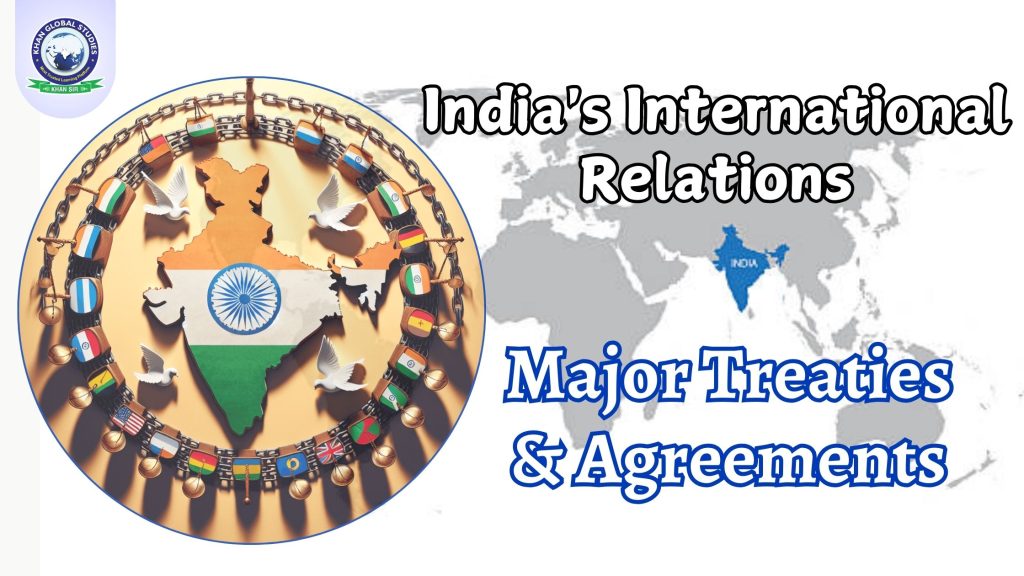India’s geopolitical importance has made it a major player in the international arena, especially due to its geographical location and historical significance. Over the years, India has participated in numerous treaties and agreements that have shaped its foreign relations and promoted its security, stability, and economic growth. These agreements span across its neighbours and major global powers. In this article, we will explore some of the most important diplomatic treaties that have defined India’s international relations.
Details of India’s International Relations
India-Pakistan Relations and Major Treaties
Indus Waters Treaty (1960)
The Indus Waters Treaty signed between India and Pakistan holds crucial importance for the management of water resources. This World Bank-mediated treaty divides the rivers of the Indus river system between the two countries. Under this agreement, the Eastern Rivers (Ravi, Beas, and Sutlej) were allotted to India, while the western rivers (Indus, Jhelum, and Chenab) were given to Pakistan. Despite the strained relations between the two countries, this treaty has been an important step in preventing water-related conflicts.
Tashkent Agreement (1966)
After the Indo-Pakistani War of 1965, both countries signed the Tashkent Agreement with the aim of restoring peace. This treaty, signed in Tashkent, USSR, emphasized the return of territories seized during the war and marked a ceasefire. While this agreement helped re-establish diplomatic relations between the two countries, it failed to resolve core issues such as Kashmir.
Shimla Agreement (1972)
After the Indo-Pakistani War of 1971, the Shimla Agreement was signed to settle disputes through bilateral talks. This treaty established the Line of Control (LoC), recognized as the de facto border between India and Pakistan in Kashmir. It is one of the most important treaties, promoting peaceful dialogue as the primary means of resolving future conflicts.
India-Bangladesh Relations and Treaties
Treaty of Friendship, Cooperation and Peace (1971)
India played a key role in Bangladesh’s independence from Pakistan, and the Treaty of Friendship between India and Bangladesh strengthened their relationship. The treaty emphasized mutual respect for sovereignty and non-interference in internal affairs. Additionally, both nations are committed to assisting each other in times of external threats, thereby promoting a strategic partnership.
Ganga Water Sharing Treaty (1996)
The Ganga Water Sharing Treaty is one of the most important agreements between India and Bangladesh regarding water resources. The treaty provides a framework for the fair distribution of the waters of the Ganges River, which is vital for the agricultural and economic sustenance of both countries. This 25-year-old agreement has played a key role in maintaining good relations between the two countries.
Land Boundary Agreement (2015)
The Land Boundary Agreement (LBA) was a historic milestone in resolving long-standing border disputes between India and Bangladesh. Under this agreement, the two countries exchanged enclaves and resolved issues related to undefined boundaries, thus promoting border stability and reducing potential flashpoints for conflict.
India-Bhutan Relations: Strategic Agreements
India-Bhutan Treaty of Friendship (1949, amended 2007)
The original India-Bhutan Treaty of Friendship of 1949 laid the foundation for the strategic partnership between the two countries. The treaty emphasized mutual respect for sovereignty and non-interference in internal affairs. An amendment in 2007 modernized the treaty, giving Bhutan greater independence in its foreign policy, while maintaining strong defense and economic ties with India.
Hydropower Agreements
India and Bhutan have developed strong cooperation in the hydropower sector. Notable projects such as the Chukha Hydropower Project and the Mangdechhu Hydropower Project have been beneficial to both countries. India helps finance these projects, and in return, it imports clean energy, which strengthens the economic partnership and boosts Bhutan’s economy.
India-China Relations: Diplomatic Efforts and Border Issues
The Panchsheel Agreement (1954)
The Panchsheel Agreement was an important attempt to establish peaceful relations between India and China. The five principles of peaceful coexistence outlined in the agreement included mutual respect for territorial integrity and sovereignty, non-aggression, and non-interference in internal affairs. However, the Sino-Indian War of 1962 undermined the agreement’s effectiveness, leaving relations strained for decades.
Border Peace and Tranquility Agreement (1993)
To reduce border disputes along the Line of Actual Control (LAC), India and China signed the Border Peace and Tranquility Agreement in 1993. The treaty was intended to maintain peace along the disputed Himalayan borders, although tensions have repeatedly surfaced, most recently in Ladakh.
India-Russia Relations: A Strategic Alliance
The Indo-Soviet Treaty of Peace, Friendship and Cooperation (1971)
One of the most important agreements in India’s Cold War diplomacy was the Indo-Soviet Treaty. This treaty provided India with a strategic shield during the Indo-Pak War of 1971, especially in terms of diplomatic and military support. It strengthened India’s long-term partnership with the Soviet Union and then Russia.
Strategic Partnership Agreement (2000)
In the post-Cold War era, India and Russia renewed their relations with the Strategic Partnership Agreement of 2000. This agreement focuses on enhancing cooperation in areas such as defence, technology and trade. The long-standing India-Russia defence cooperation is based on the framework of this agreement, with arms trade being a key element of the bilateral relationship.
India-US Relations: Strengthening Cooperation
India-US Civil Nuclear Agreement (2005)
The India-US civil nuclear agreement marked a significant shift in India’s energy security and international status. The agreement allowed India to engage in civil nuclear trade despite not being a signatory to the Nuclear Non-Proliferation Treaty (NPT). This landmark deal opened avenues for nuclear power development, helping India meet its growing energy demands.
Defence Cooperation Agreement (2016)
The Defence Cooperation Agreement signed in 2016 between India and the United States enhances military logistics cooperation. The Logistics Exchange Memorandum of Agreement (LEMOA) allows both countries to use each other’s military bases to strengthen logistics support, regional security, and Indo-Pacific strategy.
India-EU Relations: Key Agreements
Cooperation Agreement (1994)
The Cooperation Agreement signed in 1994 between India and the European Union laid the foundation for a strong economic partnership. The agreement promoted trade, investment, and technological cooperation, leading to growth in bilateral ties across various sectors.
Strategic Partnership (2004)
In the year 2004, India and the European Union upgraded their relations to a strategic partnership, focusing on areas such as trade, science, technology, and culture. This partnership has significantly deepened India’s ties with Europe, making the EU one of India’s largest trading partners.
Conclusion
Its various treaties and agreements largely shape India’s international relations. These treaties have helped secure India’s economic, diplomatic, and military interests, from managing water resources with neighbours to building strategic alliances with global powers. The importance of these agreements lies in their ability to promote regional stability and foster global cooperation, which contributes to India’s development and security.
Frequently Asked Questions
Q: What is the role of treaties and agreements in India’s foreign policy?
Answer: Treaties and agreements are important in India’s foreign policy as they strengthen India’s relations with its neighbouring countries and other global powers. These treaties have helped achieve various aspects of security, stability and economic development.
Q: What is the Indus Water Treaty and what is its importance?
Answer: The Indus Water Treaty of 1960 is an agreement based on the sharing of water resources between India and Pakistan. This treaty paved the way for resolving water disputes between the two countries and ensured water availability for both countries.
Q: What are the Tashkent Agreement and Shimla Agreement?
Answer: The Tashkent Agreement was signed after the Indo-Pak War of 1965 to restore peace between the two countries. At the same time, the Shimla Agreement was signed after the 1971 war, in which both countries resolved to resolve disputes peacefully and recognize the Line of Control (LoC).
Q: What is the significance of the Ganges Water Sharing Treaty between India and Bangladesh?
Answer: This 1996 treaty aimed to establish a balance between the two countries in the distribution of the waters of the Ganges River. Under this treaty, both countries ensured equitable and sustainable use of water resources, benefiting farmers and local communities of both countries.
Q: What is the Indo-Bhutan Friendship Treaty?
Answer: The 1949 Friendship Treaty between India and Bhutan laid the foundation for close ties between the two countries. This treaty gave Bhutan a way to consult India in foreign policy, thereby strengthening ties between the two countries.
Q: What is the significance of the Panchsheel Agreement between India and China?
Answer: In 1954, India and China signed the Panchsheel Agreement, in which both countries pledged to follow principles such as peaceful coexistence, respect for sovereignty and non-interference in internal affairs. However, the 1962 war challenged this agreement.
Q: What was the significance of the Indo-Soviet Treaty of Friendship and Cooperation?
Answer: This treaty between India and the Soviet Union (Russia) in 1971 promoted defence, science, technology and economic cooperation. This treaty played an important role for India in the 1971 war.
Q: What was the purpose of the Indo-US civil nuclear agreement?
Answer: This agreement in 2005 was aimed at increasing cooperation between India and the US in the field of civil nuclear energy. This agreement exempted India from the guidelines of the NSG, thereby promoting its energy security.
Q: What was the purpose of the Strategic Partnership Agreement between India and the European Union?
Answer: This agreement in 2004 was aimed at promoting trade, science, technology and cultural cooperation. This strengthened bilateral relations between India and the European Union.
Q: What impact have these treaties had on India’s security and stability?
Answer: India’s International Relations have strengthened India’s security, encouraged economic growth and strengthened India’s position internationally. These have created stable and cooperative relations between India and various countries, which have also been beneficial for global peace and stability.




